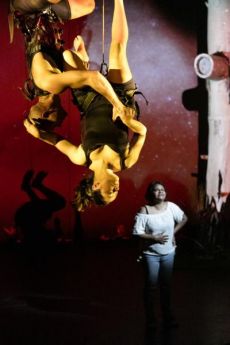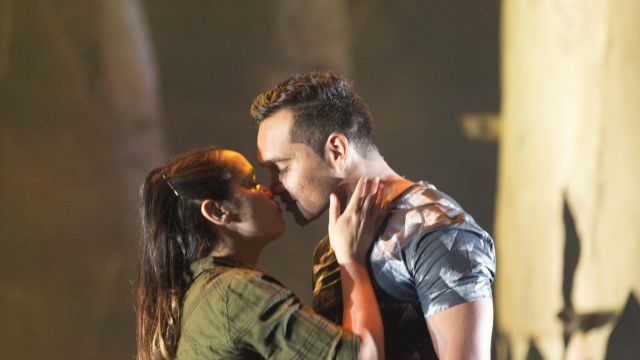The Man With the Iron Neck
It is a sad truth that indigenous people are twice as likely to commit suicide than other Australians. The reasons are many and complicated. And, in a world premier for the Brisbane Festival, The Man With the Iron Neck wrangles this difficult subject matter like a three-ring circus. It deals simultaneously with the haunting impact of colonisation, Aussie masculinity and racism in sport, and how young people deal with disturbing ripples in their family’s history.
This is one-act theatre at its best. The short form succinctly and poetically raises awareness of a critical social issue. Clever set design incorporates creative use of drone photography and projections to ‘double expose’ us to a number of great Australian paradoxes: the beauty of our landscape contrasting with the harsh reality of our history; the freedom of our wide open spaces versus the trap of mundane suburbia; one family’s survival instinct and humour set against the inescapable shockwaves and taboo of suicide.
The performance space is a simple set using an Aussie back yard, Hills Hoist and gum tree, with the dramatic back projections imparting a sense of country. We are immediately drawn in to the suburban setting where award-winning playwright/performer, Ursula Yovich is a young Mum, bringing up her twins, Bear and Evelyn as best she can after her husband’s suicide. As Evelyn, Caleena Sansbury thrives with female resilience. Playing her brother Bear, Kyle Shilling is flighty and funny, but weighed down with personal demons. As their mutual best friend, Ash, Tibian Wyles is the light and positive force, trying to keep his love for Evelyn and his mateship with Bear on an even keel. He promises them both escape – a fairytale wedding for Evelyn, and a career in football for Bear. The character mirrors Wyles’s own life experience, using dance and comedy to shed light on the horror of youth suicide.

The serious subject matter is not coldly spoon-fed. It is imparted by warm and generous performances by a young cast of superb actors who are primarily trained in dance. Their movement skills are highlighted by astute use of aerial acrobatics. The Hills Hoist becomes an acrobatic high-wire, a safety net and also a cage. Harnesses and wires hold Evelyn and Bear in balletic positions, bathed in red projections that are amniotic fluid and beautiful burnt earth, in a visually and emotionally moving scene as their mother gives birth to her twins. Later, as Bear struggles with his identity and racist taunts, we see his thoughts as the stage backdrop – a cinematic swirl of colonial relics, shameful violence and family ghosts.
To cope with his friend’s death, Ash obsesses about The Great Peters – The Man With the Iron Neck – a death-defying Circus star. He struggles to keep going and follow his own dreams. In the end, his own death-defying act is his decision to let go – a heart-wrenching coda to an emotional piece. And, while I know the performances must be gruelling for the cast, I hope this play tours the rest of Australia to maximise its exposure and raise awareness where it is needed most.
Despite such a serious theme, the play is warm and inclusive – the difficult subject acknowledged in the opening ‘Welcome to Country’ by Bob Weatherall, Gumulray Elder and Aboriginal activist. Those who need help dealing with the topic were invited to talk to a member of staff afterwards around a makeshift ‘campfire’. This experience outside the theatre brought the connections full circle – encouraging our need to talk and to acknowledge the strength in our friendships and our communities. Mr Weatherall joined the Producer, Cecily Hardy, stagehands, theatre staff and audience members as we filled in slips of paper revealing what helps us through tough times, and also something we want to let go of. Seeing those strips of paper burn was therapeutic. And the message to confront the issue and find a way to move on was, I hope, a positive invitation to those affected by the play’s themes.
Beth Keehn
Subscribe to our E-Newsletter, buy our latest print edition or find a Performing Arts book at Book Nook.

